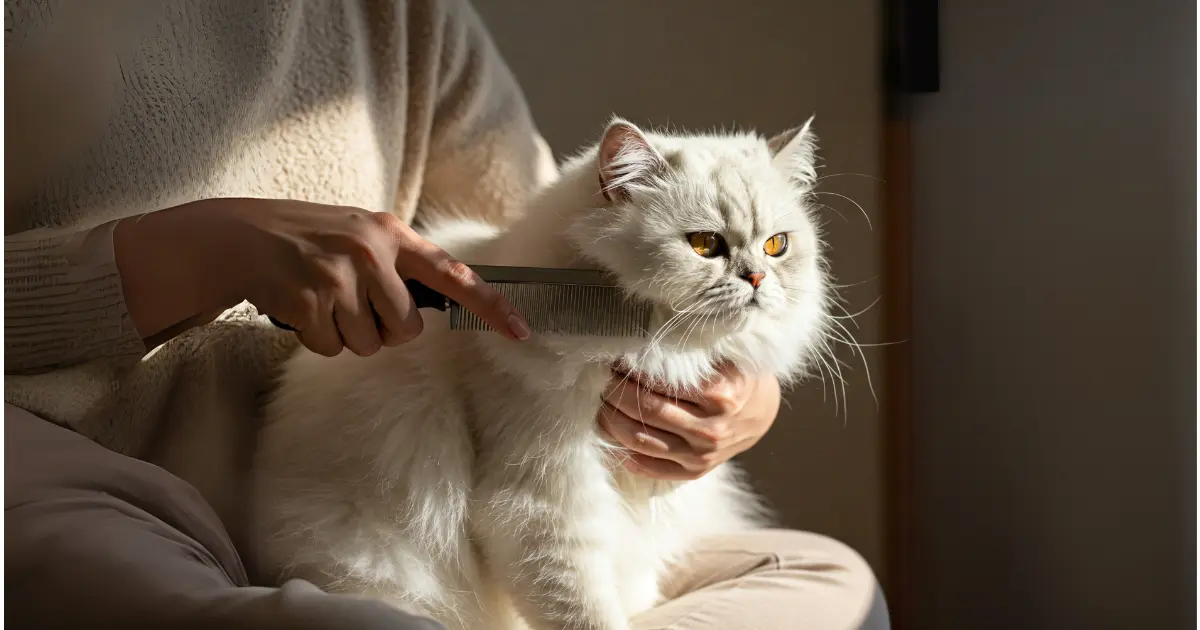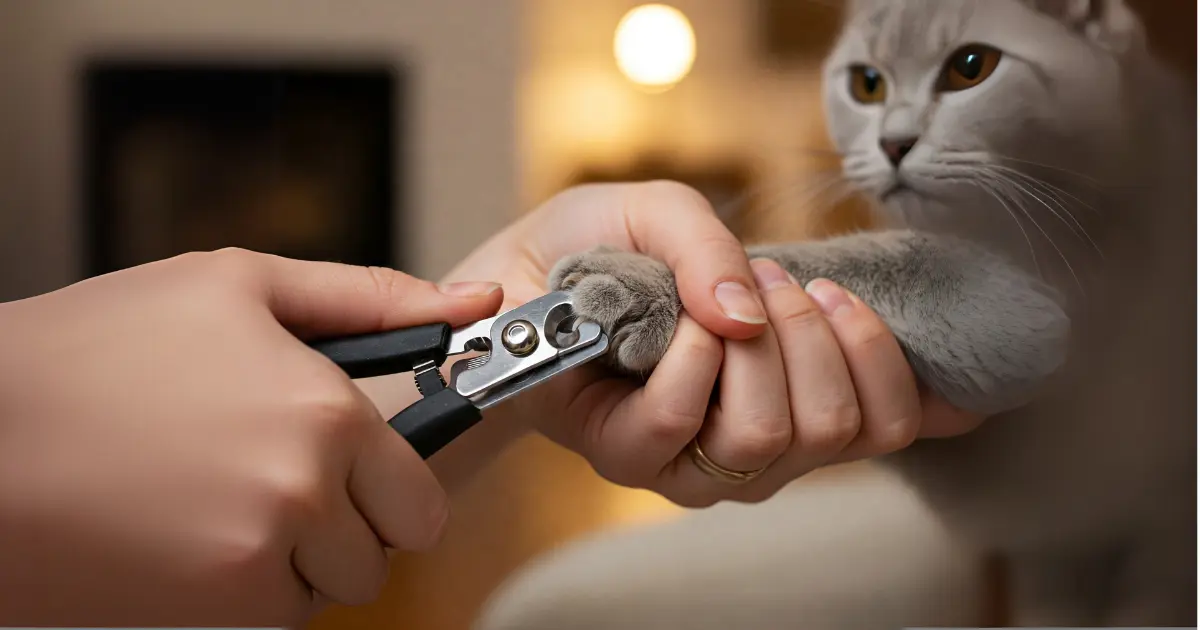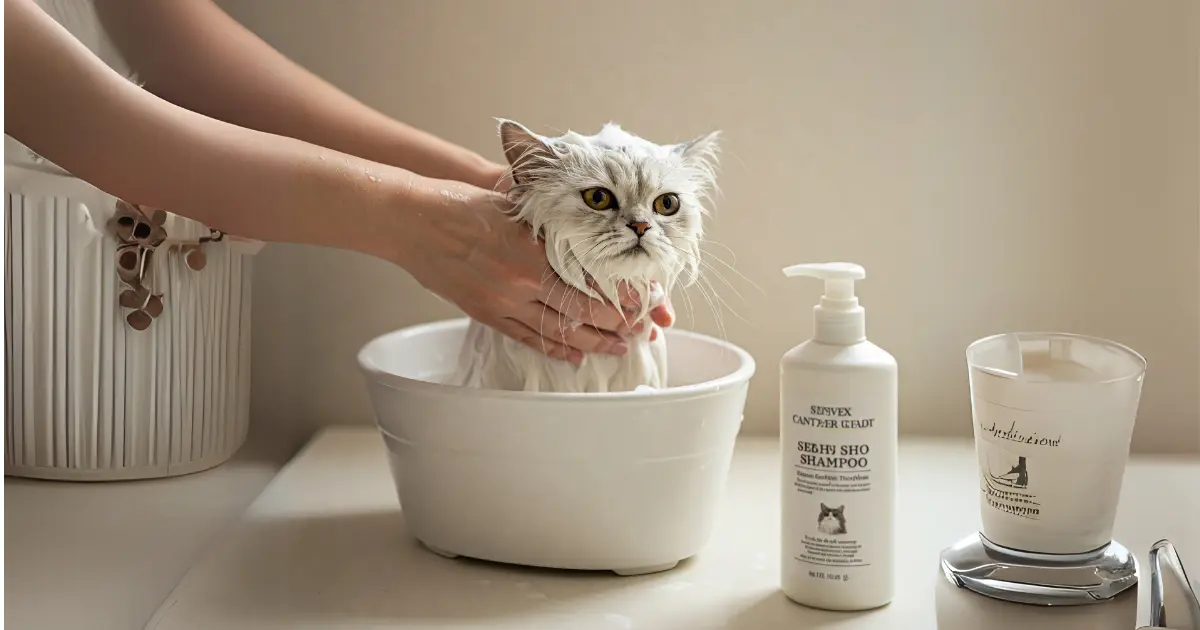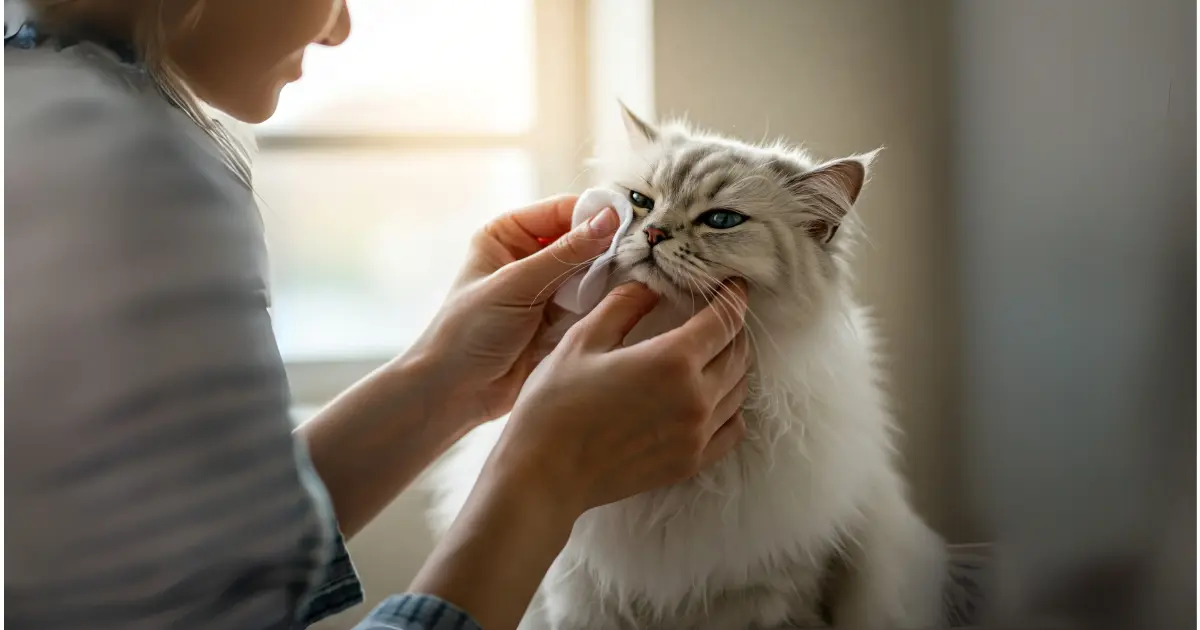Persian Cat Grooming Tips: Keep Your Cat Beautiful & Healthy
Published: 10 Feb 2025
Grooming my Persian cat, Luna, was initially daunting, but it’s worth it. Her long, beautiful coat needed more attention than I had anticipated. I initially thought it would be easy, but after a chaotic first session—fur everywhere and a very annoyed cat—I quickly realized I was over my head. But I figured it out after some trial and error (and much patience). I’m here to share the Persian Cat Grooming tips that helped me become a grooming pro!

Table of Contents
Why Grooming Your Persian Cat Is So Important
Grooming isn’t just about keeping your Persian cat looking good—it’s essential for their overall well-being. A healthy grooming routine helps with a lot more than just keeping them looking pretty:
- No More Mats: Persian cats have thick fur, which makes them prone to tangles and mats. If left unchecked, these can lead to uncomfortable skin irritation.
- Fewer Hairballs: Regular brushing removes excess fur and prevents hairballs. Trust me, you’ll save yourself a lot of mess around the house!
- A Health Check: Grooming isn’t just about the fur—it’s a great way to check for skin problems, irritations, or even fleas. It’s like a mini health check every time you groom!

Essential Grooming Tools for Persian Cats
Using the right grooming tools changed the game for me. I found out that not all brushes and combs are right for long-haired cats like mine. Here’s what you’ll need for a smooth and stress-free grooming session:
1. Wide-Tooth Comb
This comb is excellent for detangling fur without pulling on it. I use mine to gently work out knots from Luna’s fur, especially around the ears and under her chin, where mats tend to form.
2. Slicker Brush
A slicker brush helps remove loose hair and keeps Luna’s coat shiny. Be careful, though—too much pressure can irritate the skin, so go gentle.
3. Nail Clippers
- Yes, Persian cats need their nails trimmed regularly. It can be tricky, but a good pair of cat-specific clippers makes the process easier and less stressful for you and your cat.
4. Shampoo & Conditioner
- I swear by using a gentle, cat-friendly shampoo for Luna’s baths. She doesn’t get bathed constantly, but when she does, I make sure the products are safe and non-drying for her sensitive skin.
Pro Tip: If your cat tends to shed a lot (and let’s face it, most Persians do), Furminator brushes are incredible. I use one during shedding season, and it keeps fur from flying everywhere.
How to Groom Your Persian Cat: Step-by-Step Guide
Now, let’s get into the nitty-gritty of grooming. It’s not as complicated as it seems once you get the hang of it, and it’s a great way to bond with your cat!
1. Brushing Your Persian Cat
How often? Ideally, brush your Persian cat every day. It sounds like a lot, but regular brushing helps prevent mats, reduces shedding, and keeps your cat comfortable.
Here’s how I do it:
- Start from the Head: I always begin by brushing Luna’s face, ears, and neck. These areas tend to get tangled easily, so I take my time. Use a gentle, wide-tooth comb here.
- Work Down the Body and Legs: Slowly work your way down to the body and legs. I try to be mindful of Luna’s comfort, so I always brush in the direction her fur grows.
- Finish with the Belly and Tail: The belly is a tricky spot for Luna—she’s not always thrilled about it. But I always finish with the tail and belly because they can easily get matted. Take it slow, and give your cat plenty of breaks.
My Tip: If you’re dealing with a big tangle, don’t yank at it. I use a gentle detangling comb and work from the ends of the fur toward the skin. It takes time, but it’s worth it.

2. Bathing Your Persian Cat
Bathing a Persian is a whole different challenge. When I first tried it, Luna wasn’t too thrilled. It’s a little easier (though still a process!). Bathing can be tricky, especially for breeds like the Persian. You might also want to check out a Sphynx kitten bathing routine, as the principles are quite similar.
How often? Every 4 to 6 weeks is usually enough unless your cat gets dirty or has a skin condition.
Steps to Bathe Your Persian:
- Prep the Water: Lukewarm water is a must—nothing too hot or cold. I fill a small tub or sink with just enough water to cover her belly.
- Shampoo: Choose a gentle, cat-safe shampoo. Rub the shampoo into Luna’s fur and rinse thoroughly to avoid irritation.
- Drying: This part is tricky! After towel-drying her, I use a blow dryer on the cool setting. Luna’s not a fan, but she tolerates it. If your cat’s more sensitive, stick to towel drying and let them air dry in a warm room.
Pro Tip: Start with smaller steps if your cat is terrified of water. I started by getting Luna used to the sound of running water and the feel of a damp washcloth on her fur. It helped ease her into the process.
3. Nail Trimming
I used to be so nervous about trimming Luna’s nails. But over time, I learned how to do it without stressing her out (too much). Trimming your Persian’s nails is part of their grooming routine. But don’t forget about other hygiene practices too! Clean your cat’s teeth regularly for a full grooming session.
How often? Every 2-3 weeks should prevent those claws from growing too long.
How to Trim:
- Get Good Clippers: I use cat-specific clippers. They’re smaller and more precise, which helps make the process smoother.
- Take Your Time: It’s best to do it slowly, especially if your cat’s nervous. I take breaks between each paw so Luna isn’t overwhelmed. Some cats even get treats after every successful nail trim!
- Be Careful Around the Quick: The quick is the pink area inside the nail, and cutting into it can cause pain. I only trim the sharp tips, avoiding the quick.
Tip: If Luna’s resistant, I trim one or two nails at a time, then reward her with a treat. It keeps the process positive for both of us.

Managing Tear Stains
Let’s read about the tear stains that come with the Persian breed. It’s normal, but that doesn’t make it any less annoying.
How to Clean Tear Stains:
- Use a soft, moist cloth to wipe around your cat’s eyes daily. I do this in the morning while Luna’s still groggy so she doesn’t mind as much.
- If stains build up, I use a special tear stain remover that’s safe for cats. Just apply it gently with a cotton ball.
Preventing Stains:
Regular grooming, especially around the eye area, is crucial for managing tear stains. But don’t forget to clean your Persian’s ears too—check out these cat ear-cleaning tips for complete care. Luna’s always had tear stains, but keeping up with her grooming routine helps keep them under control.
Conclusion
Grooming your Persian cat might seem overwhelming initially, but with the right tools, patience, and much love, it can become a fun part of your and your furry friend’s day. Could you make sure your cat is comfortable every step of the way? With these tips, I promise you’ll have a happy, healthy, and beautiful Persian cat in no time!
For more comprehensive care tips and advice on your cat’s overall well-being, including health issues beyond grooming, check out PetMD’s comprehensive guide on cat care.”
FAQ
Q: How often should I bathe my Persian cat?
Every 4-6 weeks should be fine. You may need to bathe them more often if they’re getting into something messy or shedding excessively.
Q: Can I use regular shampoo on my Persian cat?
Not! Use a shampoo made specifically for cats. Human shampoos can strip their fur of essential oils and irritate their skin.
Q: My cat hates being brushed. Do you have any tips?
Try short sessions at first, gradually increasing the time. Use treats and praise to help your cat associate grooming with something positive. Be patient!
Q: How can I stop my Persian cat’s fur from looking oily?
To keep the coat from becoming greasy, daily brushing helps distribute natural oils and prevents buildup. You can lightly rub a dampened cloth over their coat to remove excess oil for extra shine.
Q: Can I clean my Persian cat’s face with regular wipes?
Avoid using regular wipes, as they may contain harsh chemicals. Option for wipes made specifically for cats, or gently use a moist cloth to clean their face without irritating them.
Q: Why does my Persian cat have dry skin, and what can I do?
Environmental factors, diet, or infrequent grooming can cause dry skin in Persians. Ensuring regular brushing, a diet with healthy fats like fish oil, and using a hydrating shampoo can help soothe and prevent dryness.
Q: Should I trim the fur around my Persian cat’s feet?
Trimming the fur around their paws prevents clumps of fur from matting or collecting dirt. Use rounded-tip scissors to carefully snip any excess hair, ensuring you don’t cut too close to the paw pads.
Q: What do I do if I can’t untangle a mat on my Persian coat?
Taking your cat to a professional groomer is safest if a mat is too tough to untangle. They have the right tools and experience to remove mats without causing harm or stress to your cat.

- Be Respectful
- Stay Relevant
- Stay Positive
- True Feedback
- Encourage Discussion
- Avoid Spamming
- No Fake News
- Don't Copy-Paste
- No Personal Attacks



- Be Respectful
- Stay Relevant
- Stay Positive
- True Feedback
- Encourage Discussion
- Avoid Spamming
- No Fake News
- Don't Copy-Paste
- No Personal Attacks





